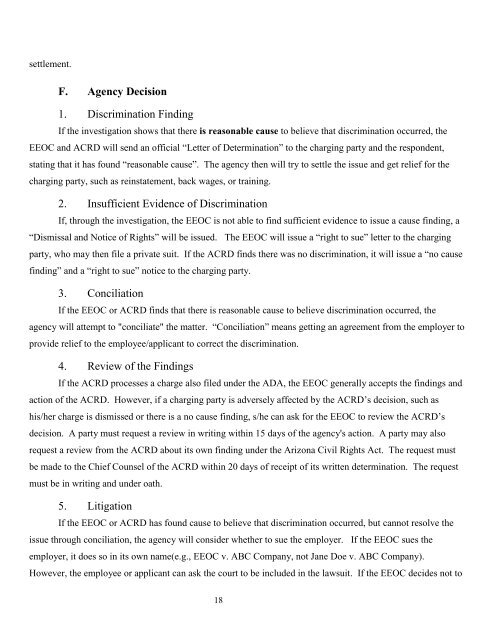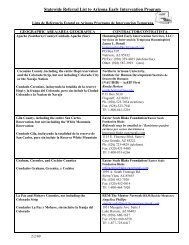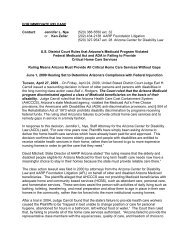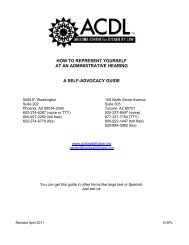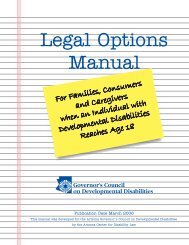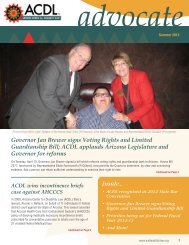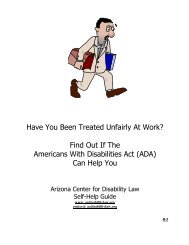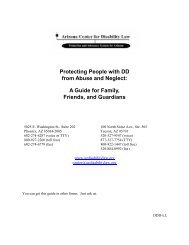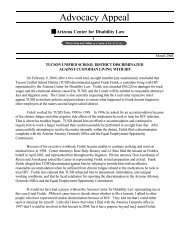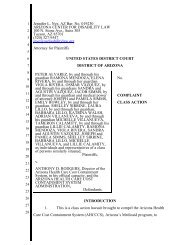How to Enforce Employment Rights Under the Americans with ...
How to Enforce Employment Rights Under the Americans with ...
How to Enforce Employment Rights Under the Americans with ...
Create successful ePaper yourself
Turn your PDF publications into a flip-book with our unique Google optimized e-Paper software.
settlement.F. Agency Decision1. Discrimination FindingIf <strong>the</strong> investigation shows that <strong>the</strong>re is reasonable cause <strong>to</strong> believe that discrimination occurred, <strong>the</strong>EEOC and ACRD will send an official “Letter of Determination” <strong>to</strong> <strong>the</strong> charging party and <strong>the</strong> respondent,stating that it has found “reasonable cause”. The agency <strong>the</strong>n will try <strong>to</strong> settle <strong>the</strong> issue and get relief for <strong>the</strong>charging party, such as reinstatement, back wages, or training.2. Insufficient Evidence of DiscriminationIf, through <strong>the</strong> investigation, <strong>the</strong> EEOC is not able <strong>to</strong> find sufficient evidence <strong>to</strong> issue a cause finding, a“Dismissal and Notice of <strong>Rights</strong>” will be issued. The EEOC will issue a “right <strong>to</strong> sue” letter <strong>to</strong> <strong>the</strong> chargingparty, who may <strong>the</strong>n file a private suit. If <strong>the</strong> ACRD finds <strong>the</strong>re was no discrimination, it will issue a “no causefinding” and a “right <strong>to</strong> sue” notice <strong>to</strong> <strong>the</strong> charging party.3. ConciliationIf <strong>the</strong> EEOC or ACRD finds that <strong>the</strong>re is reasonable cause <strong>to</strong> believe discrimination occurred, <strong>the</strong>agency will attempt <strong>to</strong> "conciliate" <strong>the</strong> matter. “Conciliation” means getting an agreement from <strong>the</strong> employer <strong>to</strong>provide relief <strong>to</strong> <strong>the</strong> employee/applicant <strong>to</strong> correct <strong>the</strong> discrimination.4. Review of <strong>the</strong> FindingsIf <strong>the</strong> ACRD processes a charge also filed under <strong>the</strong> ADA, <strong>the</strong> EEOC generally accepts <strong>the</strong> findings andaction of <strong>the</strong> ACRD. <strong>How</strong>ever, if a charging party is adversely affected by <strong>the</strong> ACRD’s decision, such ashis/her charge is dismissed or <strong>the</strong>re is a no cause finding, s/he can ask for <strong>the</strong> EEOC <strong>to</strong> review <strong>the</strong> ACRD’sdecision. A party must request a review in writing <strong>with</strong>in 15 days of <strong>the</strong> agency's action. A party may alsorequest a review from <strong>the</strong> ACRD about its own finding under <strong>the</strong> Arizona Civil <strong>Rights</strong> Act. The request mustbe made <strong>to</strong> <strong>the</strong> Chief Counsel of <strong>the</strong> ACRD <strong>with</strong>in 20 days of receipt of its written determination. The requestmust be in writing and under oath.5. LitigationIf <strong>the</strong> EEOC or ACRD has found cause <strong>to</strong> believe that discrimination occurred, but cannot resolve <strong>the</strong>issue through conciliation, <strong>the</strong> agency will consider whe<strong>the</strong>r <strong>to</strong> sue <strong>the</strong> employer. If <strong>the</strong> EEOC sues <strong>the</strong>employer, it does so in its own name(e.g., EEOC v. ABC Company, not Jane Doe v. ABC Company).<strong>How</strong>ever, <strong>the</strong> employee or applicant can ask <strong>the</strong> court <strong>to</strong> be included in <strong>the</strong> lawsuit. If <strong>the</strong> EEOC decides not <strong>to</strong>18


